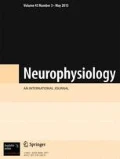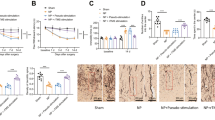We demonstrated that, under conditions of the development of experimental pancreatitis accompanied by a decrease in locomotor and orientational-research activity of animals and also by the development of the stress state, concentrations of the soluble and membrane isoforms of neuronal cell adhesion molecule (NCAM) change in the cerebellum and thalamus.
Similar content being viewed by others
References
Yu. M. Stepanov and N. G. Zaichenko, “Chronic pancreatitis: biliary mechanism, factors, and time course,” Zaporozh. Med. Zh., 70, No. 1, 46-50 (2012).
R. K. Tandon and P. K. Garg, “Oxidative stress in chronic pancreatitis: pathophysiological relevance and management,” Antioxidants Redox Signal., 15, No. 10, 2757-2766 (2011).
C. Çöl, K. Dinler, O. Hasdemir, et al., “Oxidative stress and lipid peroxidation products: effect of pinealectomy or exogenous melatonin injections on biomarkers of tissue damage during acute pancreatitis,” Hepatobiliary Pancreat. Dis. Int., 9, No. 1, 78-82 (2010).
A. Catalá, “Lipid peroxidation of membrane phospholipids generates hydroxy-alkenals and oxidized phospholipids active in physiological and/or pathological conditions,” Chem. Phys. Lipids, 157, 1-11 (2009).
D. Zhen, L. Jun, L. Rong, and H. Xiao Hua, “Experimental pancreatitis results in increased bloodbrain barrier permeability in rats: A potential role of MCP-1,” J. Digest. Dis., 13, 179-185 (2012).
B. J. Page, D. F. Toit, C. Muller, et al., “An immunocytochemical profile of the endocrine pancreas using an occlusive duct ligation model,” J. Pancreas, 4, No. 1, 191-203 (2000).
T. T Ngo, H. M. Lenhoff, and A. Yaklich, Enzyme-Mediated Immunoassay [Russian translation], Mir, Moscow (1988).
M. Bradford, “Rapid and sensitive methods for the quantitation of microgram quantities of protein utilizing the principle of protein-dye binding,” Anal. Biochem., 72, 248-254 (1985).
J. Bureš, O. Burešova, and J. Hewstone, Technique and Basic Experiments for Studying the Brain and Behavior [Russian translation], Vyssh. Shkola, Moscow (1991).
A. Petrie and C. Sabin, Medical Statistics at a Glance [Russian translation], Geotar-Med, Moscow (2003).
L. H. Brennaman and P. F. Maness, “NCAM in neuropsychiatric and neurodegenerative disorders,” Adv. Exp. Med. Biol., 663, 299-317 (2010).
M. Hagiyama, N. Ichiyanagi, K. B. Kimura, et al., “Expression of a soluble isoform of cell adhesion molecule 1 in the brain and its involvement in directional neurite outgrowth,” Am. J. Pathol., 174, No. 6, 2278-2289 (2009).
S. Zecchini, L. Bombardelli, A. Decio, et al., “The adhesion molecule NCAM promotes ovarian cancer progression via FGFR signaling,” EMBO Mol. Med., 3, 480-494 (2011).
R. Kleene, M. Mzoughi, G. Joshi, et al., “NCAMinduced neurite outgrowth depends on binding of calmodulin to NCAM and on nuclear import of NCAM and fak fragments,” J. Neurosci., 32, No. 30, 10784-10798 (2010).
Author information
Authors and Affiliations
Corresponding author
Rights and permissions
About this article
Cite this article
Makarchouk, V.A., Ushakova, G.O. Redistribution of Cell Adhesion Proteins in the Brain and the Peculiarities of Behavioral Phenomena in Rats with Chronic Pancreatitis. Neurophysiology 46, 177–179 (2014). https://doi.org/10.1007/s11062-014-9425-6
Received:
Published:
Issue Date:
DOI: https://doi.org/10.1007/s11062-014-9425-6




